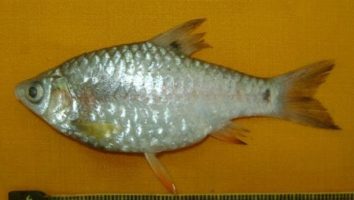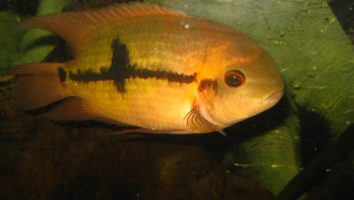The salt and pepper catfish (AKA the corydoras) is a beautiful and unique freshwater fish that is perfect for any community tank.
This species is peaceful, easy to care for, and very active. They’re also a great addition to any cleanup crew!
But before you go out and buy one (or a few), there are a few things you should know about salt and pepper catfish care. In this guide, we’ll teach you everything you need to know.
Table of contents
Species overview
The salt and pepper catfish (scientific name: Corydoras habrosus) is a freshwater fish that’s native to South America. It’s found in Peru, Ecuador, Colombia, and Brazil.
This is a schooling fish, which means it prefers to live in groups. In the wild, they can be found in rivers and streams with a sandy bottom and plenty of vegetation.
The salt and pepper catfish is a peaceful fish that gets along well with other tank mates. It’s a bottom-dweller, so it will spend most of its time near the bottom of the tank.
This fish is named for its distinct coloration. The body is a light brown or tan color, and it’s covered in black spots.
The salt and pepper catfish is a popular choice for freshwater aquariums. It’s a hardy fish that’s easy to care for, and it’s a peaceful addition to any community tank.
Appearance

The first thing you’ll notice about this species is their coloration. As the name suggests, they’re a black and white fish. The black spots are scattered all over their body (hence the “salt and pepper” name).
The base color of their body is typically a light gray or white. The spots start small near the head and get larger as they go down the body. Some specimens have more spots than others.
The spots on the fins are usually more distinct than on the body. The dorsal fin has 3-4 large black spots near the base and the anal fin has 2-3.
The pectoral and ventral fins are usually unmarked or have very small spots. Corydoras catfish have a forked caudal fin that’s shorter than the rest of their body.
This species has a very long and slender body shape. They have a slightly rounded belly and their head is relatively small (when compared to the rest of their body).
One of the most distinct features of this fish is the 3 pairs of barbels around their mouth. These barbels help them find food in murky water and they’re very sensitive.
Lifespan
Corydoras Catfish are one of the longest living freshwater fish species with a lifespan of up to 20 years.
That being said, most Corydoras Catfish only live to be about 10 years old in captivity.
The main reason for this difference is that Corydoras Catfish in the wild have much more space to swim around and are not as stressed as those in captivity.
Size
The size of a salt and pepper catfish can range anywhere from 2 to 4 inches in length. Corydoras, on the other hand, only grow to be about 2.5 inches in length.
Tank
Tank Size
The recommended minimum tank size for a single salt and pepper catfish is 20 gallons. This fish is a schooling fish so you will need at least 5 fish to make them feel comfortable. If you want to keep a school of 10 fish you will need a 40 gallon tank.
Water Parameters
Corydoras catfish are one of the most popular freshwater aquarium fish for a reason. They’re hardy, relatively easy to care for, and make a great addition to any community tank.
One of the best things you can do for your Cory catfish is to provide them with an environment that mimics their natural habitat as closely as possible. That includes replicating the water parameters they’re used to in the wild.
Cory catfish come from slow-moving rivers and streams in South America. The water is typically warm, slightly acidic, and well-oxygenated.
Here are a few basic parameters to help create a healthy environment for your Cory catfish.
- Water temperature: 70 to 80 degrees Fahrenheit
- pH levels: 6.0 to 7.5
- Water hardness: 2 to 12 dGH
- Alkalinity Levels: 3-10 dKH
What To Put In Their Tank
The first thing you need to do when setting up a tank for these fish is to choose the right substrate. We recommend a fine gravel since it’s small enough that they can’t ingest it and it won’t damage their barbels.
Next, you need to add some plants. These fish love to hide, so the more plants you have the better. We recommend using live plants since they’re more durable and provide a better hiding spot.
You should also add some driftwood or rocks to the inside of the tank. These provide additional hiding spots and help create a more naturalistic environment.
Finally, you need to add a filter. These fish are very sensitive to water quality so a good filter is a must. We recommend using an external canister filter since they’re very efficient at keeping the water clean.
Common Diseases
These fish are relatively hardy and don’t often get sick. However, there are a few diseases that you should be aware of, just in case.
The most common disease that affects these fish is ich. This is a parasite that will attach itself to your fish and cause white spots to form on the body, fins, and gills.
If left untreated, ich can be fatal. However, it’s relatively easy to treat if you catch it early. The most common treatment is to raise the temperature of the water, which will speed up the life cycle of the parasite and cause it to fall off of the fish.
There are also a few other diseases that can affect these fish, but they’re not as common. Some of these include bacterial infections, fungal infections, and parasites.
As with any other fish, the best way to prevent these diseases is to maintain clean and stable water conditions. A healthy environment will lead to healthy fish who are less likely to get sick.
Behavior & Temperament
The salt and pepper corydoras is a peaceful community fish that does best in groups. These bottom-dwellers are shy by nature and will spend most of their time hiding among plants, caves, and other objects in the tank.
They’re most active at night when they venture out to feed. During the day, they rest in hiding spots or lie in wait for food to come to them.
Although they’re peaceful, salt and pepper corydoras can be nippy. They may nibble on the fins of long-finned fish or slow-moving fish. This is usually more of a nuisance than a cause for concern, but it’s something to keep in mind if you’re considering adding them to your tank.
Tank Mates
Corydoras are a popular freshwater fish for community tanks. They’re peaceful, easy to care for, and can do well in a variety of conditions.
Their small size also makes them ideal tank mates for other small fish. Corydoras don’t get too big, so they won’t outcompete smaller fish for food.
They’re also social creatures that do well in groups. Corydoras are happiest when kept in schools of at least six fish. This is something to keep in mind when choosing their tank mates.
Corydoras are also bottom-dwellers. This trait limits the number of compatible tank mates since many fish prefer different levels of the water column.
Some good salt and pepper catfish tank mates include:
- Tetras
- Danios
- Guppies
- Mollies
- Platies
- Swordtails
Breeding
It’s not too difficult to breed salt and pepper catfish. You’ll need to set up a breeding tank and make sure the water conditions are just right. These fish are egg-layers, so you’ll need to remove the adults once the eggs have been laid.
Here are the steps you need to take:
1. Set up a breeding tank. It should be at least 20 gallons and have a sponge filter.
2. The water should be soft and slightly acidic. Aim for a pH of 6.5 and a hardness of 3-5 dGH.
3. Add some live plants and a few hiding places. Driftwood is a good option.
4. When ready, add 6-8 fish to the tank. Aim for a ratio of 2-3 females for every male.
5. The female will lay her eggs on the plants or driftwood. The male will fertilize them.
6. Once the eggs have been laid, remove the adults. They will likely eat the eggs.
7. The eggs will hatch in 7-10 days. Feed the fry baby brine shrimp or other small live foods.
Conclusion
The salt and pepper catfish is a beautiful and unique fish that is perfect for any aquarium. They are very easy to care for and get along well with other community fish.
They are also a very active fish that will help keep your tank clean. Overall, we think they are a great addition to any aquarium and would highly recommend them to anyone looking for a new fish!












